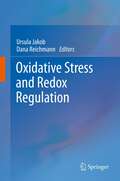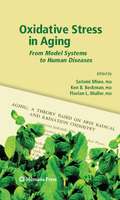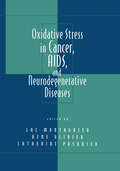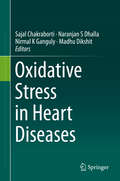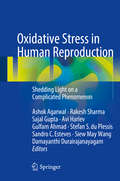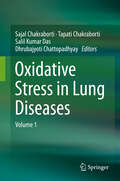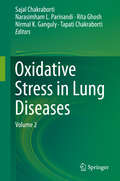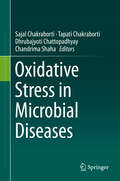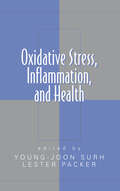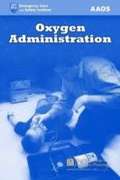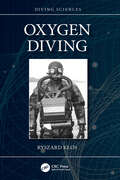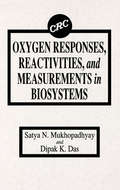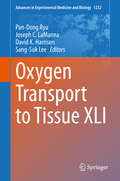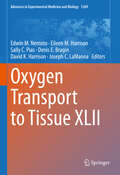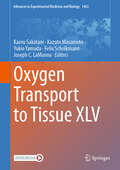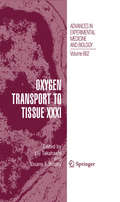- Table View
- List View
Oxidative Stress and Redox Regulation
by Ursula Jakob Dana ReichmannMany physiological conditions such as host defense or aging and pathological conditions such as neurodegenerative diseases, and diabetes are associated with the accumulation of high levels of reactive oxygen species and reactive nitrogen species. This generates a condition called oxidative stress. Low levels of reactive oxygen species, however, which are continuously produced during aerobic metabolism, function as important signaling molecules, setting the metabolic pace of cells and regulating processes ranging from gene expression to apoptosis. For this book we would like to recruit the experts in the field of redox chemistry, bioinformatics and proteomics, redox signaling and oxidative stress biology to discuss how organisms achieve the appropriate redox balance, the mechanisms that lead to oxidative stress conditions and the physiological consequences that contribute to aging and disease.
Oxidative Stress and Toxicity in Reproductive Biology and Medicine: A Comprehensive Update on Male Infertility Volume II (Advances in Experimental Medicine and Biology #1391)
by Kavindra Kumar Kesari Shubhadeep RoychoudhuryVolume Two advances the exploration of the fundamental principles of oxidative stress and toxicity on male (and female) reproduction. It includes the advances in research on male reproductive health, the impact of environmental factors, the protective measures using bioactive compounds and traditional medicines, and how to limit toxic exposure. It includes coverage of: Oxidative stress and male infertilityEnvironmental stressors and sexual healthHeavy metals, pesticides, fine particle toxicity and male reproductionProtective measures against oxidative stress in gametes/embryos by using bioactive compounds/phytomedicines in Assisted Reproductive Technology (ART)Role of reactive oxygen species on female reproductionRadiation and mutagenic factors affecting the male reproductive systemBoth volumes provide a comprehensive look at the most basic concepts and advanced research being conducted by world famous scientists and researchers in male infertility and reproduction.
Oxidative Stress and Toxicity in Reproductive Biology and Medicine: A Comprehensive Update on Male Infertility- Volume One (Advances in Experimental Medicine and Biology #1358)
by Kavindra Kumar Kesari Shubhadeep RoychoudhuryThis book discusses the role of oxidative stress in human reproduction with a focus on men’s health. The physiological roles of reactive oxygen species (ROS) in male fertility are the focus in this book. This topic is important because oxidative stress is a result of the imbalance between ROS and antioxidants in the body which may lead to sperm damage (DNA or count), deformity, and eventually, male infertility. Therefore, for a better understanding of the molecular mechanisms related to male genotoxicity and its regulation in infertility, this book provides an up-to-date view on the impact of oxidative stress factors in male reproduction . The main aim of this book is to collect a series of research articles and reviews from a diverse group of scientists to share their research work on the role of ROS or oxidative stress in physiological and pathological states in relation to (in)fertility in the male. This book presents various state-of-the-art chapters of the recent progress in the field of cellular toxicology and clinical manifestations of various issues related to men’s health and fertility. Topics include cell signaling, DNA damage and infertility, the pathophysiology of disease instigation and distribution, immune toxicity and prevention.
Oxidative Stress in Aging
by Florian Muller Kenneth Bruce Beckman Satomi MiwaHuman aging is a complex phenomenon. This state-of-the-art book discusses the role of free radicals in aging in different animal models, as well as the relevance of free radicals on age-related diseases and pathological conditions in humans (following an introduction section of the basics and theory of free radicals). In addition, the major interventions trials of antioxidant supplements in age-related disease, cancer and so forth are reviewed and discussed.
Oxidative Stress in Cancer Biology and Therapy
by Kenneth J. Dornfeld Koyamangalath Krishnan David Gius Douglas R. SpitzDuring the last 30 years it has become clearly evident that oxidative stress and free radical biology play key roles in carcinogenesis, cancer progression, cancer therapy, and normal tissue damage that limits treatment efficacy during cancer therapy. These mechanistic observations have led to the realization that free radical biology and cancer biology are two integrally related fields of investigation that can greatly benefit from cross fertilization of theoretical constructs. The current volume of scientific papers was assembled under the heading of Oxidative Stress in Cancer Biology and Therapy in order to stimulate the discussion of how the knowledge gained in the emerging field of oxidative stress in cancer biology can be utilized to more effectively design interventions to enhance therapeutic responses while causing fewer treatment limiting complications. The chapters contained in this volume provide highly informative emerging perspectives on how that selective enhancement of oxidative stress in cancerous tissues can be used as a target for enhancing therapeutic outcomes as well as how selective inhibition of oxidative stress could spare normal tissue damage and inhibit carcinogenesis. In this regard, the book represents an outstanding resource for both basic and translational scientists as well as clinicians interested in the field of oxidative stress and cancer therapy.
Oxidative Stress in Cancer, AIDS, and Neurodegenerative Diseases
by Luc Montagnier Rene Olivier Catherine PasquierBased on a conference on Oxidative Stress and Redox Regulation, held at the Pasteur Institute, Paris, this work examines fundamental, chemical, biological and medical studies of free radicals on different targets and the consequences of their reactivity. It covers the chemistry and biochemistry of free radicals, free radicals as second messengers t
Oxidative Stress in Heart Diseases
by Sajal Chakraborti Naranjan S Dhalla Nirmal K Ganguly Madhu DikshitThis book bridges the gap between fundamental and translational research in the area of heart disease. It describes a multidisciplinary approach, and demonstrates biochemical mechanisms associated with dysregulation of redox signaling, which leads heart disease. Presenting recent studies on improved forms of ROS scavenging enzymes; specific inhibitors for different ROS generating enzymes; and oxidant induced signaling pathways and their antagonists that allow subtle modulation of redox signaling, it also discusses the spatial and temporal aspects of oxidative stress in the cardiovascular system, which are of vital importance in developing better strategies for treating heart disease. Each chapter offers researchers valuable insights into identifying targets for drug development for different types of heart disease.
Oxidative Stress in Human Reproduction
by Ashok Agarwal Rakesh Sharma Damayanthi Durairajanayagam Stefan S. Du Plessis Sajal Gupta Avi Harlev Sandro C. Esteves Gulfam Ahmad Siew May WangThis SpringerBrief discusses the role of oxidative stress in the reproductive system. The book reviews endogenous sources, methods of determining its levels in body fluid/tissues, the physiological roles of ROS, as well as its negative effects on the human reproductive processes. Also discussed are multiple extrinsic factors that could induce oxidative stress in the reproductive system. This brief covers various clinical pathologies related to the reproductive system that arise from or produce oxidative stress, both in the male and female. The use of antioxidants as a therapeutic measure to keep ROS levels in check are highlighted, describing the outcome of various clinical studies involving antioxidant supplementation in infertile patients. Infertility is a global disease that affects 15-25% of all couples, and oxidative stress arising from a multitude of sources has been implicated as one of the major contributing factors to the decline in human fertility. As such, this book provides an up-to-date review on the significance of ROS in human reproduction.
Oxidative Stress in Lung Diseases: Volume 1
by Sajal Chakraborti Tapati Chakraborti Salil Kumar Das Dhrubajyoti ChattopadhyayThis first volume of the comprehensive, two-volume work on oxidative stress in lung disease introduces the molecular mechanisms, and the role of oxidants in the progression of different lung diseases. The lungs of humans and animals are under constant threat from oxidants from either endogenous (e.g. in situ metabolic reactions) or exogenous sources (e.g. air pollutants). Further, oxidative stress causes the oxidation of proteins, DNA and lipids, which in turn generates secondary metabolic products. The book consists of sections, each focusing on different aspects of oxidant-mediated lung diseases. As such it is a unique reference resource for postgraduate students, biomedical researchers and also for the clinicians who are interested in studying and understanding oxidant-mediated lung diseases. The second volume will incorporate other aspects of oxidant-mediated lung diseases, including prevention and therapeutics.
Oxidative Stress in Lung Diseases: Volume 2
by Narasimham L. Parinandi Nirmal K. Ganguly Sajal Chakraborti Tapati Chakraborti Rita GhoshThis is the second volume of the comprehensive, two-volume work on oxidative stress in lung diseases. Adopting a multidisciplinary approach, it demonstrates the cellular and molecular mechanisms associated with ROS (reactive oxygen species)-induced initiation and progression of a variety of lung diseases, such as COPD, emphysema, asthma, cystic fibrosis, occupational pulmonary diseases and pulmonary hypertension and discusses points for therapeutic intervention. The book also covers translational research and the latest research on prevention and therapeutics. Each chapter includes in-depth insights into the mechanisms associated with lung diseases and into identifying targets for drug development. Bridging the gap between fundamental and translational research, and examining applications in the biomedical and pharmaceutical industry, it is a thought- provoking read for basic and applied scientists engaged in biomedical research.
Oxidative Stress in Microbial Diseases
by Sajal Chakraborti Tapati Chakraborti Dhrubajyoti Chattopadhyay Chandrima ShahaThis book discusses recent advances in our understanding of the role of oxidants in microbial pathophysiology, providing valuable insights into the complex role of reactive oxygen species (ROS) in host-microbial interactions. The various chapters take readers through the function of ROS in infections ranging from viral to bacterial, and describe how microorganisms have developed complex strategies to not only avoid contact with phagocyte-derived oxidants, but also protect themselves from injury when oxidants are encountered. Featuring the latest research in the field of microbial diseases, this timely book is a ready reference for scientists looking to develop new anti-microbial drugs.
Oxidative Stress, Inflammation, and Health (Oxidative Stress and Disease)
by Lester Packer Young-Joon SurhSpecifically focusing on the redox regulation of cell signaling responsible for oxidative stress and inflammatory tissue damage, this reference provides a comprehensive overview of cutting-edge research on the intracellular events mediating or preventing oxidative stress and pro-inflammatory processes induced by endogenous and xenobiotic factors-an
Oxidative Stress: Human Diseases and Medicine
by Yuanyuan Zhang Canhua HuangThis book offers a systematic review of the cutting-edge knowledge in stress medicine. Cellular redox imbalance, resulting from overproduction of reactive oxide species (ROS), leads to oxidative stress and subsequent occurrence and development of many diseases, such as cancer, diabetes, pain, etc. In addition, ROS can induce post-translational modification of proteins and play roles through redox signaling pathways. In this book, the authors attempt to re-define the key concepts in oxidative stress, such as oxidative eustress and oxidative distress, revisit the pivotal signaling of oxidative stress in human diseases, and discuss the debate in current anti-oxidant strategies, such as natural products and drug repurposing. This book serves as a reference to graduate students and researchers in this growing field.
Oxygen Administration
by American College of Emergency Physicians Staff American Academy of Orthopaedic Surgeons (AAOS) Staff José V. SalazarProviding supplemental oxygen to those that need it is an essential element of emergency care. Oxygen Administration is designed to provide an understanding of how to safely handle and administer oxygen in various settings. Key topics discussed in the Oxygen Administration course include: the components that make-up a supplemental oxygen system; the various types of supplemental oxygen devices; important safety, storage, service, and maintenance steps regarding the use of supplemental oxygen systems; the importance of supplemental oxygen in the care of victims of sudden illness or injury; and using supplemental oxygen equipment when providing care for a breathing or non-breathing victim.
Oxygen Diving (Diving Sciences)
by Ryszard KlosThe book provides a derivation of the models used for calculating the risk and hazard of central oxygen toxicity pertaining to diving-based studies consistent with the research conducted earlier by the Royal Navy and the US Navy. This book forms the basis for extending the possibility of undertaking nitrox dives in combination with oxygen dives, thus significantly increasing tactical capabilities of conducting diving special operations. Features: provides derivation of the models used for calculating the risk and hazard of central oxygen toxicity improves oxygen diving procedures described in the US Navy Diving Manual includes procedures applicable to undertaking nitrox dives in combination with oxygen dives pitches the material at highest technology readiness levels, i.e. 9 TRL aims to increase tactical capabilities of conducting diving special operations This book is aimed at researchers, professionals and graduate students in life support system design, diving submarine safety, ventilation, health, sanitary engineering, mining engineering and working environment in chambers or closed compartments.
Oxygen Responses, Reactivities, and Measurements in Biosystems
by S. N. Mukhopadhyay Dipak K. DasOxygen Responses, Reactivities, and Measurements in Biosystems meets the pressing needs of the twentieth-century biotechnological and bioengineering sciences in covering oxic reactions and oxygen transport phenomena in a single book. This book is intended for teaching senior or graduate level courses and as a self-study text for practicing biochemical and chemical engineers, biotechnologists, applied and industrial microbiologists, cell biologists, scientists involved in oxygen-free radical research, and others in related fields. The text includes thought-provoking numerical problems and short questions, conventional biochemical engineering approaches and related concepts with mathematical formulations and analysis, concepts of cell biology, basic microbiology and applied biochemistry in oxy radical research, practical approaches for the development of laboratory experiments and industrial design, and an introduction of oxygen-free radical chemistry to biotechnology and bioengineering.
Oxygen Transport to Tissue XLI (Advances in Experimental Medicine and Biology #1232)
by David K. Harrison Joseph C. LaManna Pan-Dong Ryu Sang-Suk LeeThis book presents cutting-edge papers and perspectives on the transport of oxygen to tissues by scientists in a multitude of disciplines such as biochemistry, engineering, mathematics, medicine, physics, physiology, veterinary and complementary medicine. The book is composed of the following 6 parts: Brain Oxygenation and Function, Tumor Oxygenation and Metabolism, Muscle Oxygenation and Sports Medicine, Cell Metabolism and Tissue Oxygenation, Methodology of O2 Measurements, and Special Topics. The articles in this book have been presented at the 46th annual meeting of the International Society on Oxygen Transport to Tissue (ISOTT 2018) held in Seoul, Republic of Korea, from July 1 to July 5, 2018. Academics, clinical and industry researchers, engineers, as well as graduate students who are interested in oxygen transport to tissue will find this book a great reference and a useful learning resource.
Oxygen Transport to Tissue XLII (Advances in Experimental Medicine and Biology #1269)
by David K. Harrison Joseph C. LaManna Edwin M. Nemoto Eileen M. Harrison Sally C. Pias Denis E. BraginThis book presents cutting-edge papers and perspectives on the transport of oxygen to tissues by scientists in a multitude of disciplines such as biochemistry, engineering, mathematics, medicine, physics, physiology, veterinary and complementary medicine. The book is composed of the following 6 parts: Brain Oxygenation and Function, Tumor Oxygenation and Metabolism, Muscle Oxygenation and Sports Medicine, Cell Metabolism and Tissue Oxygenation, Methodology of O2 Measurements, and Special Topics. The articles in this book have been presented at the 42nd annual meeting of the International Society on Oxygen Transport to Tissue (ISOTT 2019) held in Albuquerque, New Mexico, USA, from July 28 to July 31, 2019. Academics, clinical and industry researchers, engineers, as well as graduate students who are interested in oxygen transport to tissue will find this book a great reference and a useful learning resource.
Oxygen Transport to Tissue XLIII (Advances in Experimental Medicine and Biology #1395)
by Ursula Wolf Felix Scholkmann Joseph LaMannaThis book contains most of the scientific contributions during the 48th annual conference of the International Society on Oxygen Transport to Tissue (ISOTT), which was held electronically in July 2021. It includes multidisciplinary contributions from scientists (physicists, biologists and chemists), engineers, clinicians and mathematicians and covers covers all aspects of oxygen transport from air to the cells, organs and organisms; instrumentation and methods to sense oxygen and clinical evidence.
Oxygen Transport to Tissue XLIV (Advances in Experimental Medicine and Biology #1438)
by Ursula Wolf Felix Scholkmann Joseph LaMannaThis book presents cutting-edge papers and perspectives on the transport of oxygen to tissues by scientists in a multitude of disciplines such as biochemistry, engineering, mathematics, medicine, physics, physiology, veterinary and complementary medicine. The book is composed of the following 6 parts: Brain Oxygenation and Function, Tumor Oxygenation and Metabolism, Muscle Oxygenation and Sports Medicine, Cell Metabolism and Tissue Oxygenation, Methodology of O2 Measurements, and Special Topics. The articles in this book have been presented at the 49th annual meeting of the International Society on Oxygen Transport to Tissue (ISOTT 2022). Academics, clinical and industry researchers, engineers, as well as graduate students who are interested in oxygen transport to tissue will find this book a great reference and a useful learning resource.
Oxygen Transport to Tissue XLV (Advances in Experimental Medicine and Biology #1463)
by Joseph C. LaManna Felix Scholkmann Kaoru Sakatani Kazuto Masamoto Yukio YamadaThis book presents cutting-edge papers and perspectives on the transport of oxygen to tissues by scientists in a multitude of disciplines such as biochemistry, engineering, mathematics, medicine, physics, physiology, veterinary and complementary medicine. The book is composed of the following 7 parts: 50th Anniversary, Brain, Clinical applications, Methods and techniques, Tumor Oxygenation, Tissue oxygenation and Muscle. The articles in this book have been presented at the 50th annual meeting of the International Society on Oxygen Transport to Tissue (ISOTT 2023). Academics, clinical and industry researchers, engineers, as well as graduate students who are interested in oxygen transport to tissue will find this book a great reference and a useful learning resource.
Oxygen Transport to Tissue XXXI
by Eiji Takahashi Duane F. BruleyThis book covers all aspects of oxygen delivery to tissue, including blood flow and its regulation as well as oxygen metabolism. Special attention will be paid to methods of oxygen measurement in living tissue and application of these technologies to understanding physiological and biochemical basis for pathology related to tissue oxygenation. This book is multidisciplinary and designed to bring together experts and students from a range of research fields including biochemical engineering, physiology, microcirculation, and hematology.
Oxygen Transport to Tissue XXXIII
by Martin Wolf Duane F. Bruley David K. Harrison Sabine Van Huffel Hans Ulrich Bucher Markus Rudin Ursula WolfBased on the 38th annual conference of the International Society on Oxygen Transport to Tissue (ISOTT), held in Ascona, Switzerland in July 2010, this volume covers all aspects of oxygen transport from air to the cells, organs and organisms; instrumentation and methods to sense oxygen and clinical evidence.
Oxygen Transport to Tissue XXXIV (Advances in Experimental Medicine and Biology #765)
by Duane F. Bruley David K. Harrison Fredrik Palm William J. WelchFrom the 39th annual conference of the International Society on Oxygen Transport to Tissue (ISOTT), held in Washington, DC, USA in July 2011, this volume covers aspects of oxygen transport from air to the cells, organs and organisms; instrumentation and methods to sense oxygen and clinical evidence. Oxygen Transport to Tissue XXXIV includes contributions from scientists (physicists, biologists and chemists), engineers, clinicians and mathematicians.
Oxygen Transport to Tissue XXXV (Advances In Experimental Medicine And Biology #789)
by Duane F. Bruley David K. Harrison Sabine Van Huffel Gunnar Naulaers Alexander CaicedoFrom the 40th annual conference of the International Society on Oxygen Transport to Tissue (ISOTT), held in Bruges, Belgium in August 2012, this volume covers aspects of clinical applications, muscle oxygenation, cancer, measurement technologies, oxygen transport modelling and Near-Infrared Spectroscopy (NIRS), cell metabolism and brain oxygenation. Each topic was presented by one or two invited speakers, and a series of contributed talks.
